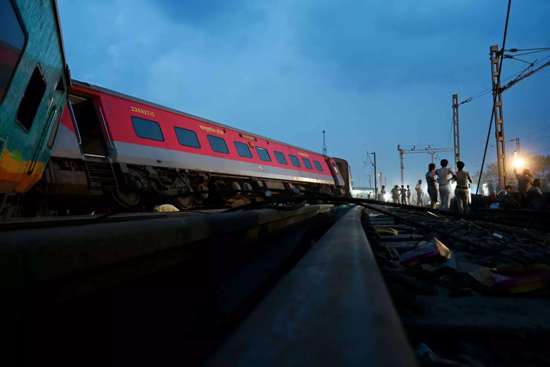Odisha Train Collision Investigation Raises Concerns about Transparency & Efficacy amidst CBI Involvement

Author: Prasanta Patnaik, Senior Media Personality
The tragic train collision in Odisha on June 2nd has left the nation reeling, with an official death toll of 288 people, a number expected to rise. However, concerns have arisen as the investigation into the accident takes a surprising turn. Instead of following the established process, the Railway Board has referred the case to the Central Bureau of Investigation (CBI), leading to questions about the transparency and efficacy of the investigation. As the public anxiously awaits answers, the decision to involve the CBI has cast a shadow over the proceedings.
Odisha Government’s Swift Response and Effective Crisis Management in Train Collision Tragedy:
In the face of the tragic train collision in Odisha, the swift response and effective crisis management by the Odisha government deserve commendation.
Odisha Chief Minister Naveen Patnaik, along with 5T Secretary VK Pandian and the entire government team, promptly arrived at the accident site to oversee the situation. Their presence and proactive approach played a crucial role in managing the crisis and providing immediate assistance, including the timely treatment of the injured.
The presence of the Chief Minister and his team at the site highlights their dedication and commitment to the welfare of the people.
Their hands-on approach in coordinating relief efforts and ensuring the injured received prompt medical attention demonstrates the government’s responsiveness and concern for its citizens.
Amidst the chaos and devastation, the Odisha government’s timely intervention and effective crisis management undoubtedly alleviated the suffering of the victims and their families. Their swift action reflects their commitment to prioritizing the well-being of the people and underscores the importance of strong leadership during times of crisis.
It is crucial to acknowledge and appreciate the efforts of Odisha Chief Minister Naveen Patnaik, 5T Secretary VK Pandian, and the entire government team for their commendable response and effective management of the tragic accident. Their dedication and proactive approach serve as an example of responsible governance and their efforts deserve recognition.
The Legal Framework for Railway Accident Investigations:
The Railways Act of 1989 outlines the procedure for investigating railway accidents. It mandates the appointment of a Chief Commissioner for Railway Safety (CCRS) and other Commissioners of Railway Safety as deemed necessary by the Central Government. The Act specifies that any passenger train accident resulting in loss of life is classified as a “serious accident.” Consequently, it becomes the responsibility of the Commissioner of Railway Safety (CRS) to conduct an inquiry into the cause of the accident.
The Inquiry Process and the Role of the CRS:
The process of inquiry, as detailed in the Statutory Investigation into Railway Accidents Rules -1998, emphasizes transparency and public participation. Upon receiving notification of a serious accident, the CRS notifies the concerned railway and sets a date, time, and place for the inquiry. A formal notice of inquiry is sent to the railway, with a copy provided to the CCRS, Railway Board, and the Secretary of Civil Aviation. Additionally, public notices are published in newspapers, inviting individuals to participate and provide evidence.
Why Did the Railway Board Deviate from the Established Process (?).
Despite the elaborate statutory mechanism in place for investigating serious train accidents, the Railway Board made the controversial decision to involve the CBI without waiting for the outcome of the CRS inquiry.
It raises concerns about the Railway Board’s haste and its potential disregard for the established process. Furthermore, no public notice for an inquiry, as mandated by law, has been published or publicized thus far. This premature involvement of the CBI may render the findings and recommendations of the CRS inquiry futile, as they ultimately require action from the Railway Board.
Systemic Apathy and Chronic Indifference:
Critics argue that even when the CRS makes recommendations, the Railway Board often fails to act upon them, as highlighted in a 2022 report by a Parliamentary panel. Shockingly, only a small percentage of train accidents undergo CRS inquiries. The catastrophe on June 2nd is undoubtedly a result of systemic apathy and negligence in implementing best safety practices. While a criminal investigation may provide a sense of punishment, it fails to address the underlying issue of the authorities’ chronic indifference to safety concerns.
The CBI Investigation: A Cloaked Criminal Probe:
The decision to involve the CBI in the investigation has raised doubts about the transparency of the process. As the saying goes, “Sunlight is the best of disinfectants,” but the State’s control over the narrative can manipulate the flow of information. The public glare, once seen as a check and balance against the State, has now transformed into an audience with a view, where performative acts take precedence over genuine accountability. By initiating a CBI investigation, the authorities have shrouded the process in secrecy, granting limited access and selectively leaking information to shape public opinion.
The Urgency for Transparent and Unbiased Inquiries:
In this critical pre-election period, concerns arise about the CBI’s workload and its ability to handle an additional case. It would have been more prudent to await the independent report from the Commission of Railway Safety after completing its inquiry. However, the Railway Board has chosen to bypass the expert statutory body responsible for investigating such accidents. Consequently, the CBI investigation, shielded from public view, risks diverting attention from long-standing systemic issues, such as inadequate safety measures, insufficient investment, and lack of staff training. It is essential that the Commission of Railway Safety fulfills its statutory mandate and addresses these concerns, irrespective of the Railway Board’s deference to the CBI.
Conclusion:
As the Odisha train collision investigation takes a new direction, questions loom regarding the transparency and effectiveness of the process. The decision to involve the CBI has raised concerns about the secrecy surrounding the investigation, diverting attention from systemic faults within the railway system. While the public yearns for accountability and justice, it is crucial that legal processes are allowed to unfold naturally and that systemic issues are adequately addressed by the authorities responsible. Only through transparent and unbiased inquiries can the nation hope to prevent such catastrophic incidents in the future.






